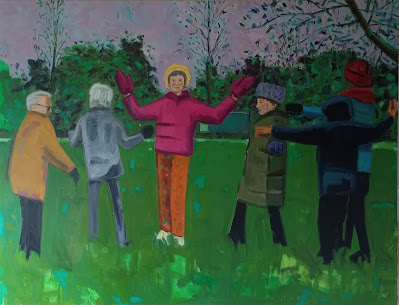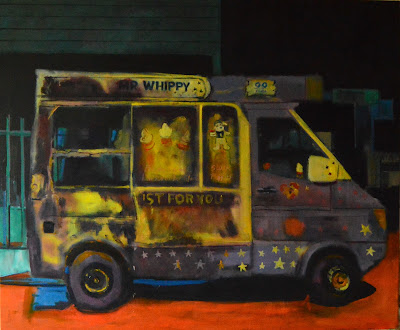The artist with artist friend, Andrew Smith installing 'The Door In The Wall' exhibition
My solo exhibition, ‘Night Walks’ overlapped in May with another exhibition in Worcester, ‘The Door In The Wall’, a two-person exhibition that I worked in collaboration on with my artist friend, Andrew Smith at The Hive, the University of Worcester Library which has a large exhibition space.
This was our second joint exhibition together, the last being ‘Displaced’, in 2021 at Birmingham’s T Street Gallery, We have also collaborated on other exhibitions together with artist, Hugh Marwood over what is now a 13-year period, and as ever, Chris Cowdrill, an illustrator friend who always produces the great publicity material for our different exhibitions, as well as occasionally exhibiting too. There is a sort of shared tone across our respective works that has worked together in the past, and there are lots of benefits to working with other artists like this.
Painting by Andrew Smith
Andrew has, since lockdown, produced an incredible range of work across different media, including painting, painted photographs, and artist’s books, video and poetry that has stemmed from processes engaged around the TV programme, ‘Homes Under the Hammer’. Taking photographs from the TV show, these are then manipulated in various creative ways, usually with paint, to suggest different, more imaginary, rooms and spaces to the rather dilapidated and careworn rooms of the houses that are sold at auction for renovation by prospective property developers.
Painting by Andrew Smith
The finished artworks have a very uneasy, haunted quality and are informed by an underlying critique of late capitalism and the property market. For ‘The Door In The Wall’ he decided to exhibit some of the painted photographs and also a selection of some terrific new paintings based on corners of rooms and empty walls, in part in response to the photographs of Uta Barth and ‘Ideal Home’ magazine. Andy wrote a great statement about this which I’ve included at the end of this post.
Paintings by Shaun Morris
Whilst Andy focussed on the interior world of his painted rooms, my own contribution was presented, intended as a contrast, a selection of my landscape paintings, but with all the work across the exhibition sharing a common interest in the eerie and the uncanny and psychological states related to this.
'The Green Door' by Shaun Morris
The title for the exhibition came from a short story by H G Wells that details the traversing of its main character from one seemingly real world to another parallel world through the ‘door in the wall’, that was referenced in Mark Fisher’s excellent book ‘The Weird and the Eerie’, which inspired many of the paintings I have made in recent years.
'The Night Watch', oil on canvas, 100 x 120cms, 2023
I also exhibited some new paintings including a large new portrait, ‘The Night Watch’, of a security guard isolated and entrapped in his ‘sentry’ box, trapped in his circumstances of low paid work borne out of his social background, which represents a nudge in the direction of some of my new work and a renewed interest in the figure.
'The. Aquarium', oil on canvas, 60 x 90cms, 2023
'TV Dinner', oil on canvas, 45 x 60cms, 2023
I also exhibited a couple of interior paintings myself, two new still life paintings based on ‘found’ still life subjects in my home. These were of the open, illuminated microwave just off my kitchen and the illuminated fish tank (with poor fish now sadly deceased…) in my darkened living room, the last light I turn off on the way to bed. There was something in the compositions and atmospheric lighting of these scenes that seemed to possess a quiet psychological charge and tension that spoke to me about my relationship with my domestic life I wanted to explore (and want to explore further).
'Figures' oil on canvas, 100 x. 120cms, 2018
The landscapes I presented were paintings from different periods of work from the last few years, with many of them from a rather sombre series I called ‘The Street’ from 2017-2018 which were developed from the unease and stress I felt hung in the air in a post-Brexit, austerity ridden Britain…I think some of them are very good, and they fitted well in the exhibition, especially one called ‘Figures’, but I had to get out of that place for my painting for my own mental well-being, although things are even worse in the country now.
Paintings by Andrew Smith
Paintings by both of us
Andy felt the exhibition was the best one we had put together so far, but I’m not so sure. I certainly felt Andy’s work was very strong and deserved an exhibition of its own. ‘The Door In The Wall’ did look good but I don’t think the venue served it that well, and we didn’t get many visitors or were supported in getting more of an audience along by The Hive’s marketing, which was disappointed. I personally felt more inclined to try and find another venue at some point, but it’s very unlikely to happen. We carry on…
Artist’s statement – Andrew Smith/HR Smoke (website: andrew-smith-h-r-smoke.com)
Over the past few years I’ve been interested in the TV programme Homes Under the Hammer, partly as a consequence of the period of lockdown and the domestic containment, or confinement, involved with that. In the private space of my living room I would be able to look into these televised private-become-public-spaces, these other, though basically similar, boxes. I began to do some work in parallel with the TV programme’s formula/narrative of improvement/development. The TV rooms before development appealed to me, or touched me perhaps, because of their usually abject state; it felt like you were – the programme’s presenters were – intruding on the traces of some private grief: a death (likely – so a house as memento mori), or the private traces of retreating economic tides (obviously, though this being an opportunity for developers to exploit – and fair play to them, say the presenters of the show: the twin abstractions of money and development mean we need not concern ourselves too much with the historical circumstances by which this house came to the market).
So I took photos of the TV screen and painted on prints of these – developing the TV rooms by painting out walls or introducing quasi-abstract Paul Klee-like tunnels or corridors, creating more space – as is frequently the case with the developers in the programme (the creating the space, not the Klee reference). I suppose the structure of the space, in the photo, functioned as something like a constraint into which one could introduce a degree of variation or interruption, and thus experience a kind of freedom. And I thought about the developers in the programme – their own constraints, financial or whatever (aesthetic?), and the hard work they put in to make the house they’d acquired at auction something that was saleable for profit – that being, so it seemed, the usual reason for developing these places; and I thought about how that related to what I was doing – that is, how peeling these images of rooms off the screen and then elaborating on them and presenting them as art, how that compared to the development work done on TV: something like, an investment/calculation within the field of property, and the various socio-economic forces that structure that, to produce a more or less calculable pay-off, versus an investment in the field of Art, hierarchically structured by various cultural and socio-economic forces, to produce … what … a feeling of imaginative freedom?
The more recent paintings on canvas follow on from an artists’ book – Downstairs Upstairs – in which the photos from the TV (again) are cropped such that they resemble minimalist abstract paintings. I was thinking of Dan Graham’s Homes for America, in which he points to the similarities between mass housing and Minimalist art, and the photos in Uta Barth’s Ground series. If situated in relation to Barth’s work, my paintings exemplify a form of non-transcendental abstraction: that is, they do not abstract to produce a rarefied conflation of domestic and gallery space – they are not ideal universalized , corners, walls, doors, as Barth says about her Ground series – rather they gesture towards forms of abstraction whilst remaining, evidently, images of rooms from the bottom end of the housing market: this isn’t LA, it’s Stoke. Or, to put it another way, the paintings as makeover – a la Homes Under the Hammer – retain a reference to socio-economic origins, or class difference. The short film Homes Movie (available via QR code in this exhibition) begins with a mock (up) version of Ideal Home magazine, with stills from later in the film juxtaposed with some of Barth’s photos, which don’t look entirely out of place in the magazine context, which I suppose in a sense supports her point that “most empty corners and doorways do look alike, so when a picture of a corner is moved to a new space it still tends to read as relating to that particular location.” The rest of the film applies some of Barth’s formal tropes – the staring at walls, the edges of things - to footage from Homes Under the Hammer: I don’t think the effect is parodic of either Barth or Homes, but it is something like an exercise in creating a disjunction between form and content.
You can paint yourself into a corner. You can turn a corner. In The Poetics of Space, his study of the house, the significances of its interior spaces, Gaston Bachelard describes the corner as “the most sordid of all havens.” It is, he says, a place for welcome withdrawal, desired immobility: one can retreat into the corner, into oneself – or emerge from the corner, into the world, to find oneself. The corner is like a “sullen uncommunicative person”, and, also, the place for memories, dreams, reflections, for the imagination – for readings in a universe of dust. To sit and read a few lines on the ceiling – or to apply a new coat of paint?
























































